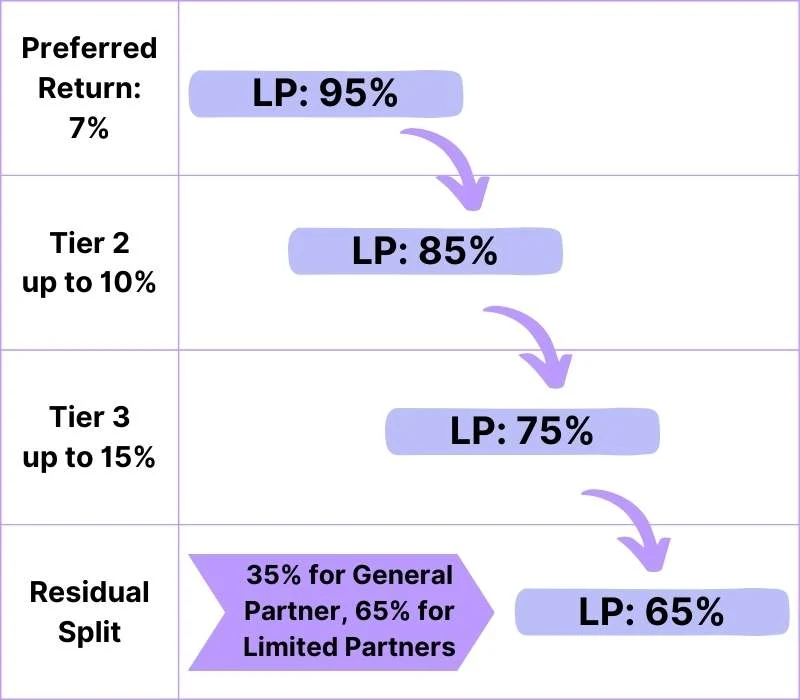
Disclaimer: This content is for informational purposes only, you should not construe any such information as legal, tax, investment, financial, or other advice. Nothing contained on our site constitutes a solicitation, recommendation, endorsement, or offer by ButterflyMX or any third-party service provider. ButterflyMX is not a financial adviser. You should always seek independent legal, financial, taxation, or other advice from a licensed professional.
When seeking funding to develop properties, one useful investment strategy that you can choose is a real estate waterfall.
In this post, we’ll cover what a real estate waterfall is and how it works. Next, we’ll explore the benefits of utilizing an equity waterfall. Finally, we’ll go over a few tips for investing in real estate waterfalls.
This post covers:
- What are waterfalls in real estate?
- How does a waterfall payout work?
- The benefits of real estate waterfalls
- Two tips for real estate waterfalls
What are waterfalls in real estate?
A real estate waterfall is a payment model for groups of investors (which are typically called real estate syndications) that dictates how and when investors receive payment.
As we’ll explore more in the next section, what sets the waterfall model apart from others is that not every investor gets paid at the same time. Additionally, some investors receive a larger percentage based on terms laid out in the contractual agreement that precedes any simple real estate waterfall model.
According to a recent report, groups of investors are responsible for nearly 18% of investments in real estate purchases. Most syndications use waterfall models that differ slightly from one another.
How does a waterfall payout work?
While the property that you’re choosing to develop likely won’t have any waterfalls on it, waterfalls are a great simile for how a real estate waterfall works.
In a real estate equity waterfall model, the water is the earnings from a specific property. The cliff or ledge that the water passes over is what’s known as a hurdle rate. The cash flow fills up a series of “pools” before spilling into the next. Each pool has a tier of investors within it.
The hurdle rate is the return on investment (ROI) that must be reached before the next pool can be filled.
Discover the top 5 multifamily design trends:
What is a typical real estate waterfall structure?
The higher tier of investors in the first pool gets paid first, followed by each subsequent lower tier of investors. This results in lower-tiered investors waiting longer to receive a return on their investment. And if a property takes a while to become profitable, this can be a long wait.
Why are there higher tiers of investors? This is likely because some investors put in more money than others or were involved in the development of the property to a higher degree than lower-tier investors.
While this is a basic summary of how a real estate waterfall works, it’s usually much more complicated than this in practice.

What is an example of a real estate syndication waterfall?
As you may know, real estate syndications feature a sponsor (the person who organizes everything) who stands apart from the rest of the investors. Sponsors often (but not always) receive more profits.
One real estate waterfall example for syndications is a preferred 10% return based on what was invested with a 60/40 split of further profits between the sponsor and the rest of the investors.
The preferred return rate is for the preferred investors (or higher-tiered). These preferred investors will be the first ones to receive a percentage of profits, which in this case has been agreed upon as 10%.
The promote is a term used to describe the special rate a sponsor gets for running the operation. This is usually a specific percentage similar to the preferred return rate.
Keep in mind: Waterfall models will be slightly different if there is more than one sponsor.
The benefits of real estate equity waterfalls
If multifamily and commercial real estate waterfall models seem complicated, they are. However, there are a number of key benefits that make them ideal for some real estate syndication groups.
The benefits of real estate waterfalls are:
- The system rewards partners who provide the most funding for an investment.
- Transparent and fair distribution.
- Software can be utilized to calculate this distribution model for you.
Two tips for real estate waterfalls
Understanding what a real estate waterfall is and how it works is one thing. Implementing them is another. The tips below will make the process of using a waterfall model easier.
Tips for real estate waterfalls include:
1. Use real estate waterfall software
When implementing a real estate waterfall model, you don’t have to be an Excel expert or hire an accountant to determine the pay structure. Instead, you can utilize real estate waterfall software such as the Cascade Suite by a software company called Deloitte.
This software helps implement a waterfall distribution model and requires little to no technical expertise on your part. All you have to do with software like this is plug in the relevant names and data.

2. Be specific with the owner’s agreement
One of the most important parts of a waterfall model precedes the investment itself, and that is the owner’s agreement.
The owner’s agreement is the legally binding document that everyone involved with a syndication or investment group agrees to abide by. One way to prevent disagreements between group members is to be extremely specific in the owner’s agreement.
Topics to elaborate upon in the owner’s agreement include:
- The preferred return rate
- Hurdle rates for each pool
- When and how each investor will be paid
- The split between investors and sponsor(s)
- Project details including expected construction start date and profitability estimates
Takeaways
- A real estate waterfall is a distribution method for groups of investors such as syndications.
- Payments for waterfall investment models work by paying out tiers of investors in the order of who contributed the most to the project.
- One of the biggest benefits of waterfalls is that they are fair and transparent.
- Tips for using waterfall models include using software and being very specific with the owner’s agreement.







